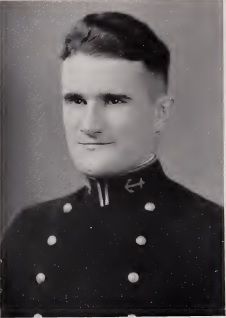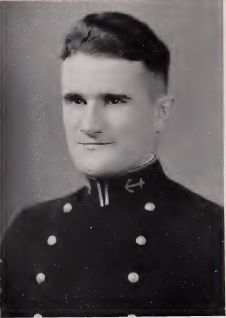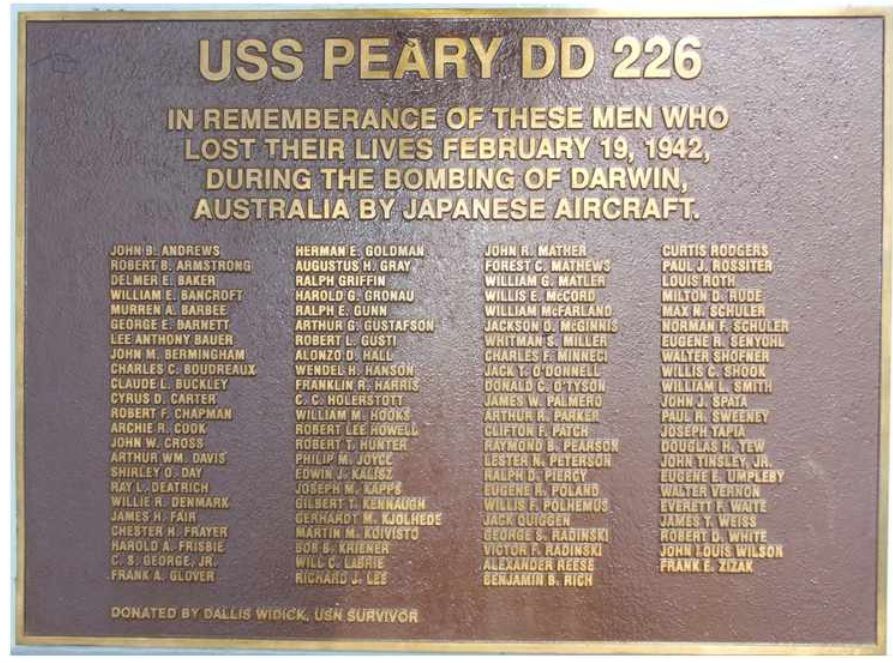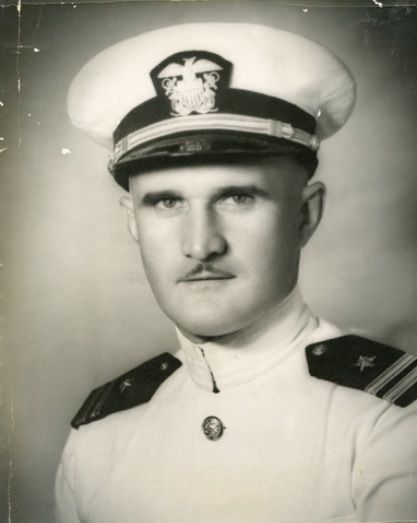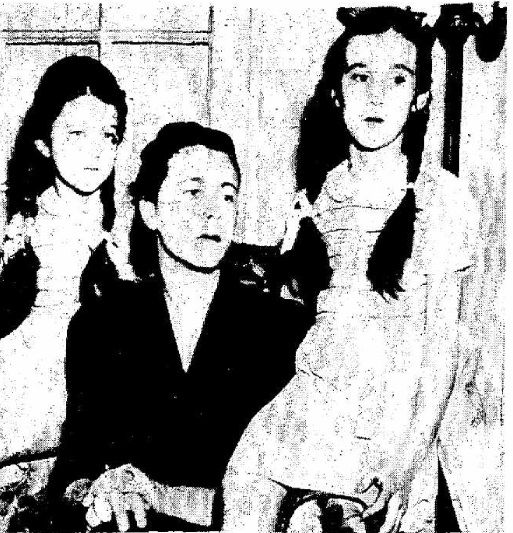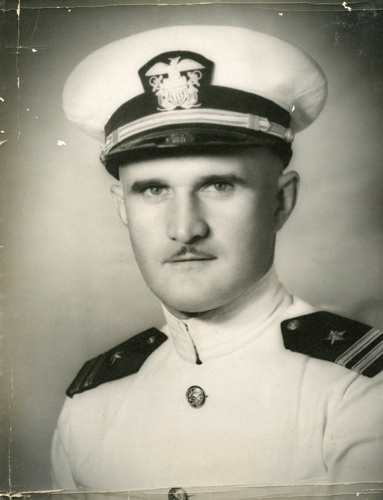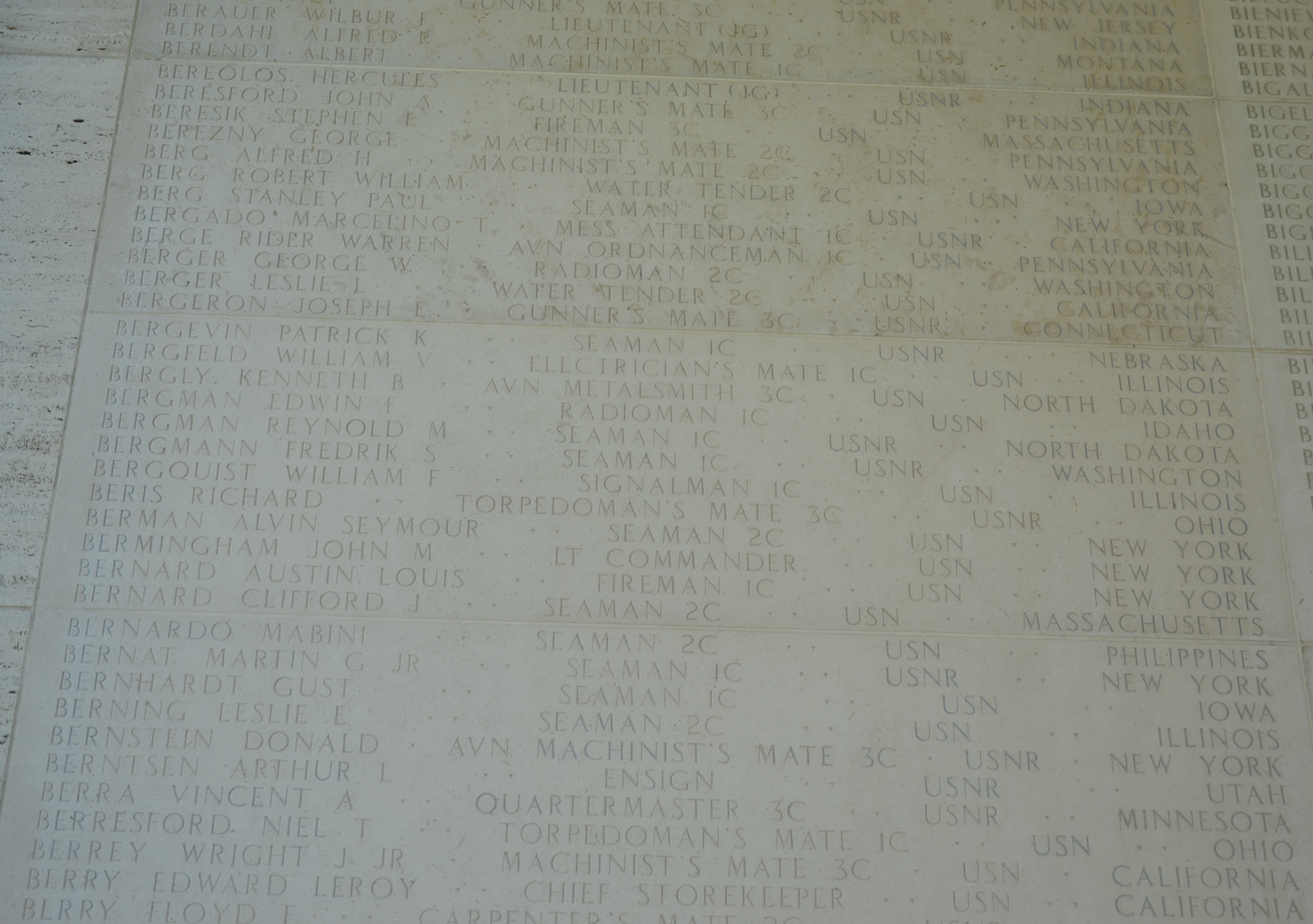View USS Peary Monument
Navy Cross Citation
The President of the United States of America takes pride in presenting the Navy Cross (Posthumously) to Lieutenant Commander John Michael Bermingham (NSN: 0-62695), United States Navy, for extraordinary heroism and distinguished service in the line of his profession as Commanding Officer of the Destroyer U.S.S. PEARY (DD-226), during operations in enemy waters of the Philippine Islands and later Dutch Timor waters during the period from 10 December 1941 to 19 February 1942.
After Manila Bay became untenable as an operating base, Lieutenant Commander Bermingham piloted his vessel to Darwin, N.T, Australia, narrowly escaping by his skillful maneuvering the attacks of bombers and torpedo planes on one occasion and avoiding further attacks during daylight by ingeniously camouflaging and hiding his ship near land.
He later carried out a second hazardous mission in delivering gasoline to an airfield which was under continual enemy surveillance.
His action and good judgment not only saved his ship in the first instance but also insured the successful accomplishment of others.
During the bombing of Darwin, Australia, by approximately 80 enemy aircraft he fought his ship valiantly against continued dive bombing attacks and went down with the U.S.S. PEARY when she finally sank.
Lieutenant Commander Bermingham's inspiring leadership and the valiant devotion to duty of his command reflect great credit upon himself and are in keeping with the finest traditions of the United States Naval Service.
He gallantly gave his life for his country.
∼John Michael was the son of Daniel Francis and Anna Lucas Bermingham. His parents were native to County Clare, Ireland and residents of Bronx, NY. John's siblings were Susan L. Preston and Veronica Flanagan. John graduated from All Hallows School in Manhattan, NY in 1924. He continued his education at Manhattan College for a year before he received an appointment to the US Naval Academy in early 1925. John entered the Academy on 16 Jun 1925. During his tenure at Annapolis, John was active in various extra-curricula activities.
His classmates wrote their thoughts about John in the 1929 Lucky Bag yearbook. They read:
"Juno"
JUNO has two respects in which he differs from the rest of the Regiment. The first is a delusion that the textbooks "prepared especially for the use of Midshipman at the United States Naval Academy" contain matter that should be remembered. To that end he concocts strange combinations of syllables such as bompheanilsloshvacku and ordulastiptop—key words, if you please, to make it next to impossible to forget the various kinds of projectile or the consideration in selecting airfoil. An excellent idea if there were only a way to insure against the regrettable blunder of using an Ordnance keyword in a Steam exam. The second is a preference for recognition in literature rather than athletics, an ambition that he considers will be realized with the twelfth rejection slip.
Otherwise he is a normal midshipman, breaks hearts with a mechanical method that savors of repetition, and says, "Now, when I was a Plebe" and the "Navy has gone to the dogs" in the proper disgusted tone. He is distinctive for a minimum of false pride, for an enviable unflagging interest in all he does, and for a passion for thoroughness, characteristics that augur well for success.
Glee Club 4, 3, 2; Gymkhana 4, 3, 2; Orchestra 2, 1; Trident Magazine 2, 1; Trident Society 2, 1; 1 P.O.
He completed his academic requirements in May 1925 standing 140th out of a graduating class of 240 midshipmen. On 05 Jun 1929, John received his diploma, accepted his commission and took the oath of office as an Ensign of the Line, USN.
After his graduation, Ensign Bermingham reported to his mandatory sea-duty tour on board the battleship, USS Wyoming (BB-32) on 13 July 1929. About a year later, Ens. Bermingham took leave to marry Mary Grace Joyce, daughter of Hubert Joseph "Hugh" and Sarah Theresa Lucas Joyce, on 09 Aug 1930 in Bronx, NY.
During the 1930s, Bermingham served under instruction as a student pilot at the Naval Air Station, Pensacola, FL, (he didn't earn his wings) then on to the destroyer USS Ellis (DD-154) during which his first child, a daughter named Sarah, was born on 01 Jun 1932 in NYC. A few days later, he was promoted to Lieutenant Junior Grade (Ltjg) on 06 Jun 1932.
That assignment was followed by a short tour of temporary duty under instruction at the Naval Ammunition Depot in Portsmouth, VA under the command of the Naval Training Station, Norfolk, VA. His next assignments were consecutive tours of duty on board destroyers USS Taylor (DD-94); USS McFarland (DD-237); and USS Hatfield (DD-231). Those tours were followed by a relatively short tour on board the battleship, USS Utah (BB-31). Just prior to detaching from Utah, the Berminghams welcomed their second child, Susan Joyce, born in NYC on 16 April 1936. In July 1936, Ltjg Bermingham was assigned as a student officer at the Post Graduate School, US Naval Academy in Annapolis, MD (Naval Academy Register, 1937). During his 3 year tour of duty at Annapolis, Bermingham was promoted to Lieutenant (Lt) on 30 Jun 1937. After he completed his Post Graduate course of study, Lt Bermingham was assigned to the staff of the Naval Academy for about a year.
Lt Bermingham received orders on 27 July 1939 to report to Asiatic Station for assignment. In Oct 1939, he reported on board the heavy cruiser, USS Augusta (CA-31) flagship of the Asiatic Fleet. Lt Bermingham became a father for the third and last time when daughter, Elizabeth B., was born on 12 Nov 1939 in Manhattan, NY.
Lt Bermingham received orders dated 23 Jan 1940 to detach from Augusta and report to the flush-deck destroyer, USS Stewart (DD-224), as her executive officer. Stewart entered the Cavite Navy Yard for overhaul on 05 April 1940 shortly after Lt Bermingham reported on board. Upon leaving the yard on 1 June, Stewart acted as plane guard vessel for seaplanes flying between Guam and the Philippines and then made a final tour of Chinese Yellow Sea ports from 7 July to 23 September 1940 as international tensions increased. Units of the Asiatic fleet would remain in the Philippines until Nov 1941.
Prelude to War.
The threat of hostilities between the United States and Japan grew closer to the boiling point as the year 1941 began. Admiral Hart, Commander in Chief, Asiatic Fleet, determined then it was time to send all of the families of his sailors home. There was push-back from the resentful spouses who initially declined to leave their husbands. It was only a threat to indefinitely restrict their spouses to their ships without leave that finally convinced the families; it was time to comply with orders and return to the continental United States (CONUS). Admiral Hart's directive probably saved many family members from internment by the Japanese or worse. For many of the married and unmarried sailors alike, it was the last time they would ever see their families.
Then, in July 1941, as Japanese aggression intensified with their move south into lower Indo-China, Admiral Hart warned his officers that he had no doubt that war would come although he didn't know how of when it would start. Hart trained his destroyer crews hard keeping them on a war-footing for extended periods and away from Cavite naval base as much as possible exercising his "defensive deployment."
Ordered to comply with the Adm. Hart's "defensive deployment" well south of Manila, units of the Asiatic Fleet including destroyer tender USS Blackhawk (AD-9), USS Stewart (DD-224) and other ships of Destroyer Division (DesDiv) 57, got underway on 25 Nov 1941, and arrived on the morning of 29 Nov 1941 in Balikpapan, a major oil port on the eastern coast of Borneo. However, Lieutenant Commander (Lcdr) Bermingham was not on board Stewart as his tour of duty had ended, and he had been detached from Stewart and was in Manila awaiting transportation back to the United States.
------------------------------------------------
The remainder of his story is best told by the following narrative published in the May 1942 issue of Shipmate:
John Bermingham's Tour of Duty is Finished
By H.V.WILEY, '15
December 1, 1941. John Bermingham's tour of duty on the Asiatic Station was finished. He had served his full "cruise" in the Far East, had been detached from duty as executive officer of one of the most efficient destroyers of the 29th Squadron. Two divisions of the squadron had departed "on a practice cruise." The other division of four ships was still in Manila, one pair completing a routine Navy Yard overhaul, the other pair waiting to replace them a week or two later.
Monday, December 8, 1941 (Manila Time). John Bermingham, his tour of duty finished, was in Manila waiting for transportation home. Over came the Japanese bombers and the war was begun. The bombing was not heavy in Manila at first, as military targets, particularly air-fields, were sought. John watched the attacks, as he was not on duty and he had little to do. On Wednesday 10 Dec, he looked across Manila Bay and saw the Navy Yard at Cavite attacked. One of the first victims was the destroyer Peary, which was completing overhaul, the Yard and the crew working desperately to get the engines together, the guns and torpedoes on board. The Peary was hit on the top of the bridge by a large bomb filled with gasoline, concrete, steel scrap, and perhaps shrapnel. Down went the foremast; down went the Captain, injured; down went the Executive Officer dead; down went the Engineer Officer, injured, and down went ten to twenty of the gallant crew—never to rise again. Two days later the torpedo officer had the ship in the harbor under steam, skillfully dodging the sticks of bombs dropped on him.
December 11, 1941. Lt. John Bermingham, his tour of duty finished, visited the Navy Yard to again inquire about means of transportation or of returning to duty. A Commander passed him in the Yard, then halted him and asked if he were not a destroyer officer, and upon receiving an affirmative answer ordered him to board the Peary and take command (CINC Asiatic Fleet orders dated 11 Dec 1941). Meanwhile the ship had assembled thirty men of various ratings in the Navy Yard to replace the killed, wounded and missing of her crew.
John Bermingham went to work, organizing and drilling the crew, fitting out with ammunition, charts, a spar for a mast, a radio transmitter, fuel, provisions, anything that could be gotten at night when the ship could come to a dock while the bombers were not around. Some of the holes were patched in the decks, but the bow which was being replaced had to be left open to the sea in many places, and the plates above water were only bolted in place. The Peary then commenced escort duty and other missions as required.
December 26, 1941. John Bermingham's tour of duty in Manila Bay was finished. Enemy forces were about to occupy Manila. At night at the Naval Base John Bermingham saw the Commandant and was told to "go on south." An hour later he was steaming through the mine-fields, and into the open China Sea, with no prescribed route or destination (Surabaya). Bombing planes were active in many sections of the Philippines. John Bermingham was on his own.
How he got through can not be published at this time, except to say that his ingenuity and fortitude were remarkable1. He evaded enemy cruisers and submarines; he was bombed by the enemy; he was bombed by friends who did not know that an Allied ship was in those waters. Ammunition was set on fire. One man stationed aft and a man at a machine gun was killed on the bridge. Another was lost overboard during action. Finally, about out of fuel, food and water he reached a small friendly port where he got enough supplies to go on.
January 3, 1942. John Bermingham's duty was finished. He reached a port where some of his own Navy was present. His bedraggled-looking ship, the smoke stacks full of holes, the bridge half gone, no mast except a boat spar, camouflaged in various ingenious ways, had reached a haven. However, another enemy was at work. Twenty-five men and officers were transferred to the hospital with malignant malaria and within three days five had died. Again a replacement crew was received. The ship was provisioned and repaired. In a few days the Peary was again at sea on war missions. One mission was particularly dangerous as it included taking supplies to a port (Timor) that was being bombed daily.
February 19, 1942. John Bermingham's tour of escort duty was finished. He had undergone two bombings during the voyage. He returned to port for fuel about 8 a.m. At about 1100 a terrific bombing attack, the first suffered by that port, came without warning. The Peary was hit aft immediately and a fire was started. The next hit was amidships and the ship started sinking. A few minutes later a bomb hit near the bridge and pierced the magazines of the thin-shelled ship. As she sank the guns above water amidships were still firing fiercely. Peary suffered 80 men killed and 13 wounded. Only one officer survived – the Engineering Officer.
Brave, competent John Bermingham's tour of duty was finished. The few survivors of his crew revere and honor him as do we all.
(Some parts of the original article have be edited by this compiler.)
Lt Bermingham was promoted to Lieutenant Commander (Lcdr) on 6 Jan 1942. He was a Lieutenant when he assumed command of Peary on 11 Dec 1941.
Lcdr Bermingham was missing and presumed dead on 19 Feb 1942. His remains were unrecoverable. He was posthumously awarded the Navy Cross Medal, Purple Heart Medal, China Service Medal, Asiatic-Pacific Campaign Medal with Fleet Clasp and three bronze battle stars, American Defense Service Medal with Fleet Clasp (one bronze star in lieu of Fleet Clasp), Philippine Defense Medal with Fleet Clasp, WWII Victory Medal, and he was probably eligible for the Combat Action Ribbon (retroactive to 07 Dec 1941).
----------------------
Navy Cross
From Hall of Valor:
The President of the United States of America takes pride in presenting the Navy Cross (Posthumously) to John Michael Bermingham, Lieutenant Commander, United States Navy, for extraordinary heroism and distinguished service in the line of his profession as Commanding Officer of the Destroyer U.S.S. PEARY, during operations in enemy waters of the Philippine Islands and later Dutch Timor waters during the period from 10 December 1941 to 19 February 1942. After Manila Bay became untenable as an operating base, Lieutenant Commander Bermingham piloted his vessel to Darwin, N.T, Australia, narrowly escaping by his skillful maneuvering the attacks of bombers and torpedo planes on one occasion and avoiding further attacks during daylight by ingeniously camouflaging and hiding his ship near land. He later carried out a second hazardous mission in delivering gasoline to an airfield which was under continual enemy surveillance. His action and good judgment not only saved his ship in the first instance but also ensured the successful accomplishment of others. During the bombing of Darwin, Australia, by approximately 80 enemy aircraft he fought his ship valiantly against continued dive bombing attacks and went down with the U.S.S. PEARY when she finally sank. Lieutenant Commander Bermingham's inspiring leadership and the valiant devotion to duty of his command reflect great credit upon himself and are in keeping with the finest traditions of the United States Naval Service. He gallantly gave his life for his country.
General Orders: Commander in Chief, Pacific: Serial 02457 (November 23, 1942)
--------------------
Lcdr Bermingham's family also received a personal commemoration from President Franklin D. Roosevelt. It reads: In grateful memory of John Michael Bermingham, who died in the service of his country, SEA, Asiatic Area, ATTACHED U.S.S. PEARY, 19 February 1942. He stands in the unbroken line of patriots who have dared to die that freedom might live and grow and increase its blessings. Freedom lives, and through it, he lives -- in a way that humbles the undertakings of most men.
(Signed) Franklin D. Roosevelt,
President of the United States
----------------------
1) Capt Bermingham used camouflage by covering his ship with Palm fronds and green paint making her look like a grove of trees. He also stayed close to shore and traveled by night. Japanese bombers passed overhead without sighting her. Peary reached Port Darwin on 03 Jan 1942.
[Bio#345 compiled by Gerry Lawton (G47/GML470)]
Military Hall of Honor ID#125454
View USS Peary Monument
Navy Cross Citation
The President of the United States of America takes pride in presenting the Navy Cross (Posthumously) to Lieutenant Commander John Michael Bermingham (NSN: 0-62695), United States Navy, for extraordinary heroism and distinguished service in the line of his profession as Commanding Officer of the Destroyer U.S.S. PEARY (DD-226), during operations in enemy waters of the Philippine Islands and later Dutch Timor waters during the period from 10 December 1941 to 19 February 1942.
After Manila Bay became untenable as an operating base, Lieutenant Commander Bermingham piloted his vessel to Darwin, N.T, Australia, narrowly escaping by his skillful maneuvering the attacks of bombers and torpedo planes on one occasion and avoiding further attacks during daylight by ingeniously camouflaging and hiding his ship near land.
He later carried out a second hazardous mission in delivering gasoline to an airfield which was under continual enemy surveillance.
His action and good judgment not only saved his ship in the first instance but also insured the successful accomplishment of others.
During the bombing of Darwin, Australia, by approximately 80 enemy aircraft he fought his ship valiantly against continued dive bombing attacks and went down with the U.S.S. PEARY when she finally sank.
Lieutenant Commander Bermingham's inspiring leadership and the valiant devotion to duty of his command reflect great credit upon himself and are in keeping with the finest traditions of the United States Naval Service.
He gallantly gave his life for his country.
∼John Michael was the son of Daniel Francis and Anna Lucas Bermingham. His parents were native to County Clare, Ireland and residents of Bronx, NY. John's siblings were Susan L. Preston and Veronica Flanagan. John graduated from All Hallows School in Manhattan, NY in 1924. He continued his education at Manhattan College for a year before he received an appointment to the US Naval Academy in early 1925. John entered the Academy on 16 Jun 1925. During his tenure at Annapolis, John was active in various extra-curricula activities.
His classmates wrote their thoughts about John in the 1929 Lucky Bag yearbook. They read:
"Juno"
JUNO has two respects in which he differs from the rest of the Regiment. The first is a delusion that the textbooks "prepared especially for the use of Midshipman at the United States Naval Academy" contain matter that should be remembered. To that end he concocts strange combinations of syllables such as bompheanilsloshvacku and ordulastiptop—key words, if you please, to make it next to impossible to forget the various kinds of projectile or the consideration in selecting airfoil. An excellent idea if there were only a way to insure against the regrettable blunder of using an Ordnance keyword in a Steam exam. The second is a preference for recognition in literature rather than athletics, an ambition that he considers will be realized with the twelfth rejection slip.
Otherwise he is a normal midshipman, breaks hearts with a mechanical method that savors of repetition, and says, "Now, when I was a Plebe" and the "Navy has gone to the dogs" in the proper disgusted tone. He is distinctive for a minimum of false pride, for an enviable unflagging interest in all he does, and for a passion for thoroughness, characteristics that augur well for success.
Glee Club 4, 3, 2; Gymkhana 4, 3, 2; Orchestra 2, 1; Trident Magazine 2, 1; Trident Society 2, 1; 1 P.O.
He completed his academic requirements in May 1925 standing 140th out of a graduating class of 240 midshipmen. On 05 Jun 1929, John received his diploma, accepted his commission and took the oath of office as an Ensign of the Line, USN.
After his graduation, Ensign Bermingham reported to his mandatory sea-duty tour on board the battleship, USS Wyoming (BB-32) on 13 July 1929. About a year later, Ens. Bermingham took leave to marry Mary Grace Joyce, daughter of Hubert Joseph "Hugh" and Sarah Theresa Lucas Joyce, on 09 Aug 1930 in Bronx, NY.
During the 1930s, Bermingham served under instruction as a student pilot at the Naval Air Station, Pensacola, FL, (he didn't earn his wings) then on to the destroyer USS Ellis (DD-154) during which his first child, a daughter named Sarah, was born on 01 Jun 1932 in NYC. A few days later, he was promoted to Lieutenant Junior Grade (Ltjg) on 06 Jun 1932.
That assignment was followed by a short tour of temporary duty under instruction at the Naval Ammunition Depot in Portsmouth, VA under the command of the Naval Training Station, Norfolk, VA. His next assignments were consecutive tours of duty on board destroyers USS Taylor (DD-94); USS McFarland (DD-237); and USS Hatfield (DD-231). Those tours were followed by a relatively short tour on board the battleship, USS Utah (BB-31). Just prior to detaching from Utah, the Berminghams welcomed their second child, Susan Joyce, born in NYC on 16 April 1936. In July 1936, Ltjg Bermingham was assigned as a student officer at the Post Graduate School, US Naval Academy in Annapolis, MD (Naval Academy Register, 1937). During his 3 year tour of duty at Annapolis, Bermingham was promoted to Lieutenant (Lt) on 30 Jun 1937. After he completed his Post Graduate course of study, Lt Bermingham was assigned to the staff of the Naval Academy for about a year.
Lt Bermingham received orders on 27 July 1939 to report to Asiatic Station for assignment. In Oct 1939, he reported on board the heavy cruiser, USS Augusta (CA-31) flagship of the Asiatic Fleet. Lt Bermingham became a father for the third and last time when daughter, Elizabeth B., was born on 12 Nov 1939 in Manhattan, NY.
Lt Bermingham received orders dated 23 Jan 1940 to detach from Augusta and report to the flush-deck destroyer, USS Stewart (DD-224), as her executive officer. Stewart entered the Cavite Navy Yard for overhaul on 05 April 1940 shortly after Lt Bermingham reported on board. Upon leaving the yard on 1 June, Stewart acted as plane guard vessel for seaplanes flying between Guam and the Philippines and then made a final tour of Chinese Yellow Sea ports from 7 July to 23 September 1940 as international tensions increased. Units of the Asiatic fleet would remain in the Philippines until Nov 1941.
Prelude to War.
The threat of hostilities between the United States and Japan grew closer to the boiling point as the year 1941 began. Admiral Hart, Commander in Chief, Asiatic Fleet, determined then it was time to send all of the families of his sailors home. There was push-back from the resentful spouses who initially declined to leave their husbands. It was only a threat to indefinitely restrict their spouses to their ships without leave that finally convinced the families; it was time to comply with orders and return to the continental United States (CONUS). Admiral Hart's directive probably saved many family members from internment by the Japanese or worse. For many of the married and unmarried sailors alike, it was the last time they would ever see their families.
Then, in July 1941, as Japanese aggression intensified with their move south into lower Indo-China, Admiral Hart warned his officers that he had no doubt that war would come although he didn't know how of when it would start. Hart trained his destroyer crews hard keeping them on a war-footing for extended periods and away from Cavite naval base as much as possible exercising his "defensive deployment."
Ordered to comply with the Adm. Hart's "defensive deployment" well south of Manila, units of the Asiatic Fleet including destroyer tender USS Blackhawk (AD-9), USS Stewart (DD-224) and other ships of Destroyer Division (DesDiv) 57, got underway on 25 Nov 1941, and arrived on the morning of 29 Nov 1941 in Balikpapan, a major oil port on the eastern coast of Borneo. However, Lieutenant Commander (Lcdr) Bermingham was not on board Stewart as his tour of duty had ended, and he had been detached from Stewart and was in Manila awaiting transportation back to the United States.
------------------------------------------------
The remainder of his story is best told by the following narrative published in the May 1942 issue of Shipmate:
John Bermingham's Tour of Duty is Finished
By H.V.WILEY, '15
December 1, 1941. John Bermingham's tour of duty on the Asiatic Station was finished. He had served his full "cruise" in the Far East, had been detached from duty as executive officer of one of the most efficient destroyers of the 29th Squadron. Two divisions of the squadron had departed "on a practice cruise." The other division of four ships was still in Manila, one pair completing a routine Navy Yard overhaul, the other pair waiting to replace them a week or two later.
Monday, December 8, 1941 (Manila Time). John Bermingham, his tour of duty finished, was in Manila waiting for transportation home. Over came the Japanese bombers and the war was begun. The bombing was not heavy in Manila at first, as military targets, particularly air-fields, were sought. John watched the attacks, as he was not on duty and he had little to do. On Wednesday 10 Dec, he looked across Manila Bay and saw the Navy Yard at Cavite attacked. One of the first victims was the destroyer Peary, which was completing overhaul, the Yard and the crew working desperately to get the engines together, the guns and torpedoes on board. The Peary was hit on the top of the bridge by a large bomb filled with gasoline, concrete, steel scrap, and perhaps shrapnel. Down went the foremast; down went the Captain, injured; down went the Executive Officer dead; down went the Engineer Officer, injured, and down went ten to twenty of the gallant crew—never to rise again. Two days later the torpedo officer had the ship in the harbor under steam, skillfully dodging the sticks of bombs dropped on him.
December 11, 1941. Lt. John Bermingham, his tour of duty finished, visited the Navy Yard to again inquire about means of transportation or of returning to duty. A Commander passed him in the Yard, then halted him and asked if he were not a destroyer officer, and upon receiving an affirmative answer ordered him to board the Peary and take command (CINC Asiatic Fleet orders dated 11 Dec 1941). Meanwhile the ship had assembled thirty men of various ratings in the Navy Yard to replace the killed, wounded and missing of her crew.
John Bermingham went to work, organizing and drilling the crew, fitting out with ammunition, charts, a spar for a mast, a radio transmitter, fuel, provisions, anything that could be gotten at night when the ship could come to a dock while the bombers were not around. Some of the holes were patched in the decks, but the bow which was being replaced had to be left open to the sea in many places, and the plates above water were only bolted in place. The Peary then commenced escort duty and other missions as required.
December 26, 1941. John Bermingham's tour of duty in Manila Bay was finished. Enemy forces were about to occupy Manila. At night at the Naval Base John Bermingham saw the Commandant and was told to "go on south." An hour later he was steaming through the mine-fields, and into the open China Sea, with no prescribed route or destination (Surabaya). Bombing planes were active in many sections of the Philippines. John Bermingham was on his own.
How he got through can not be published at this time, except to say that his ingenuity and fortitude were remarkable1. He evaded enemy cruisers and submarines; he was bombed by the enemy; he was bombed by friends who did not know that an Allied ship was in those waters. Ammunition was set on fire. One man stationed aft and a man at a machine gun was killed on the bridge. Another was lost overboard during action. Finally, about out of fuel, food and water he reached a small friendly port where he got enough supplies to go on.
January 3, 1942. John Bermingham's duty was finished. He reached a port where some of his own Navy was present. His bedraggled-looking ship, the smoke stacks full of holes, the bridge half gone, no mast except a boat spar, camouflaged in various ingenious ways, had reached a haven. However, another enemy was at work. Twenty-five men and officers were transferred to the hospital with malignant malaria and within three days five had died. Again a replacement crew was received. The ship was provisioned and repaired. In a few days the Peary was again at sea on war missions. One mission was particularly dangerous as it included taking supplies to a port (Timor) that was being bombed daily.
February 19, 1942. John Bermingham's tour of escort duty was finished. He had undergone two bombings during the voyage. He returned to port for fuel about 8 a.m. At about 1100 a terrific bombing attack, the first suffered by that port, came without warning. The Peary was hit aft immediately and a fire was started. The next hit was amidships and the ship started sinking. A few minutes later a bomb hit near the bridge and pierced the magazines of the thin-shelled ship. As she sank the guns above water amidships were still firing fiercely. Peary suffered 80 men killed and 13 wounded. Only one officer survived – the Engineering Officer.
Brave, competent John Bermingham's tour of duty was finished. The few survivors of his crew revere and honor him as do we all.
(Some parts of the original article have be edited by this compiler.)
Lt Bermingham was promoted to Lieutenant Commander (Lcdr) on 6 Jan 1942. He was a Lieutenant when he assumed command of Peary on 11 Dec 1941.
Lcdr Bermingham was missing and presumed dead on 19 Feb 1942. His remains were unrecoverable. He was posthumously awarded the Navy Cross Medal, Purple Heart Medal, China Service Medal, Asiatic-Pacific Campaign Medal with Fleet Clasp and three bronze battle stars, American Defense Service Medal with Fleet Clasp (one bronze star in lieu of Fleet Clasp), Philippine Defense Medal with Fleet Clasp, WWII Victory Medal, and he was probably eligible for the Combat Action Ribbon (retroactive to 07 Dec 1941).
----------------------
Navy Cross
From Hall of Valor:
The President of the United States of America takes pride in presenting the Navy Cross (Posthumously) to John Michael Bermingham, Lieutenant Commander, United States Navy, for extraordinary heroism and distinguished service in the line of his profession as Commanding Officer of the Destroyer U.S.S. PEARY, during operations in enemy waters of the Philippine Islands and later Dutch Timor waters during the period from 10 December 1941 to 19 February 1942. After Manila Bay became untenable as an operating base, Lieutenant Commander Bermingham piloted his vessel to Darwin, N.T, Australia, narrowly escaping by his skillful maneuvering the attacks of bombers and torpedo planes on one occasion and avoiding further attacks during daylight by ingeniously camouflaging and hiding his ship near land. He later carried out a second hazardous mission in delivering gasoline to an airfield which was under continual enemy surveillance. His action and good judgment not only saved his ship in the first instance but also ensured the successful accomplishment of others. During the bombing of Darwin, Australia, by approximately 80 enemy aircraft he fought his ship valiantly against continued dive bombing attacks and went down with the U.S.S. PEARY when she finally sank. Lieutenant Commander Bermingham's inspiring leadership and the valiant devotion to duty of his command reflect great credit upon himself and are in keeping with the finest traditions of the United States Naval Service. He gallantly gave his life for his country.
General Orders: Commander in Chief, Pacific: Serial 02457 (November 23, 1942)
--------------------
Lcdr Bermingham's family also received a personal commemoration from President Franklin D. Roosevelt. It reads: In grateful memory of John Michael Bermingham, who died in the service of his country, SEA, Asiatic Area, ATTACHED U.S.S. PEARY, 19 February 1942. He stands in the unbroken line of patriots who have dared to die that freedom might live and grow and increase its blessings. Freedom lives, and through it, he lives -- in a way that humbles the undertakings of most men.
(Signed) Franklin D. Roosevelt,
President of the United States
----------------------
1) Capt Bermingham used camouflage by covering his ship with Palm fronds and green paint making her look like a grove of trees. He also stayed close to shore and traveled by night. Japanese bombers passed overhead without sighting her. Peary reached Port Darwin on 03 Jan 1942.
[Bio#345 compiled by Gerry Lawton (G47/GML470)]
Military Hall of Honor ID#125454
Gravesite Details
Entered the service from New York.
